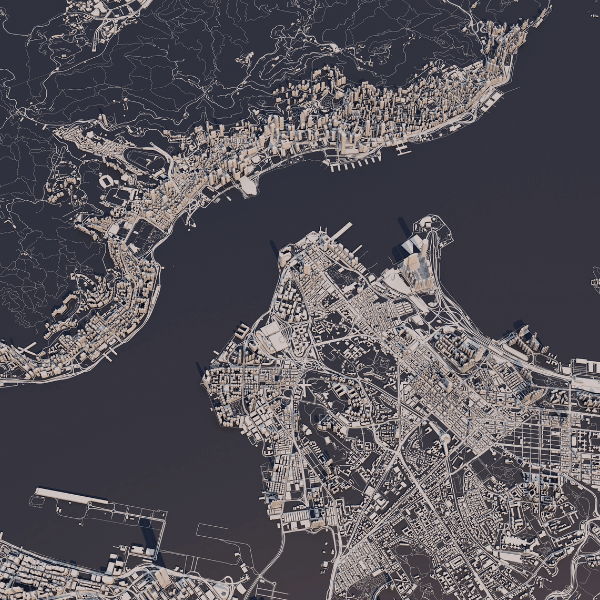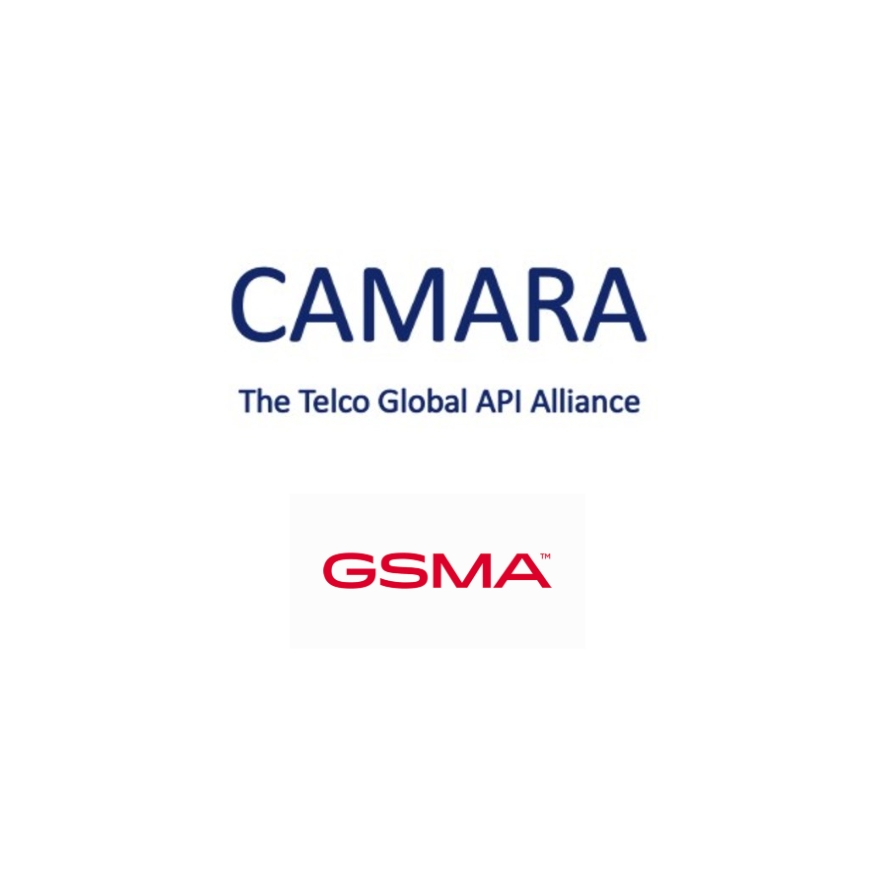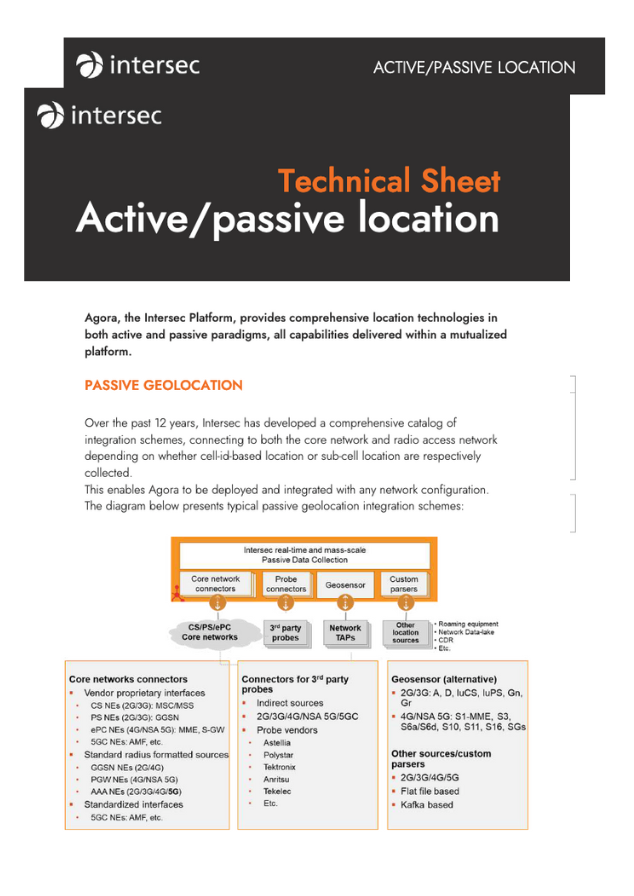TECHNOLOGY
Technologies making a positive impact
At Intersec, we use technology to improve connectivity and safety. We partner with our clients to turn their data into valuable insights, without ever compromising people's privacy.
Since our inception, we have developed innovative and disruptive tech solutions that enable fast data analytics, location intelligence, mass communication, and AI-based decisions to our clients worldwide, connecting nearly one billion humans and connected objects.
AI and fast data DNA
5G-enriched platform
Unequalled geolocation
Privacy by design
Contextual analytics
Open API platform



%20(1).jpg?width=2918&height=1946&name=P1320535%20(1)%20(1).jpg)


What makes our technology unique
Intelligence software and analytics are more important than ever to identify new revenue streams, prevent fraud, reduce waste, innovate, etc., which is why mobile network operators, industrial companies, financial institutions, and tech companies are adopting AI/ML models. Yet, these models cannot achieve their full potential due to challenges in processing massive data. Investing in more efficient system architecture to reduce data preparation and processing times is a prerequisite to moving to the next step and taking the most out of their AI/ML investment.

The time and ability to access the data are critical to make accurate and meaningful predictions of the vast quantity of information available. Fast data is part of our DNA at Intersec, as it enhances our extensive stack of location technologies through:
- Geofencing, which is a virtual perimeter for a real-world geographic area that can be dynamically generated or match a predefined set of boundaries, can now be in real-time, at scale. The ability to do so comes from access to the full database, representing hundreds of millions of subscribers, in an adaptable and agile way (dynamic definition of 10,000 zones) and high-speed detection (100ms) for a hundred million SIM cards (phones & IoT)
- Precise customer trip analysis through collected GPS data including speed, elevation, bearing, time, and more.

Our software stack has been developed to derive meaning from network-originated location data, and speed up data ingestion and processing times for more efficient resource utilization and quicker and more meaningful insights. Here are a few examples of how our clients leverage our fast data platform:
- To be effective, safety-critical applications require to access large volumes of structured and anonymized mobile datasets, in the case of mass alerting and situational awareness when a crisis arises for example
- Telcos benefit from high-quality data processing and labeling in extremely fast iteration cycles to create high customer engagement through smarter targeting and more relevant contextual marketing campaigns
- Telcos can also diversify their offerings by monetizing IoT use cases using highly precise geolocation technologies, such as the analysis and automatic identification of traces left by IoT devices in mobile network signaling to detect abnormal behavior in time
Where telcos and their enterprise clients compete for insights, timing is everything. Fast data and advanced AI/ML algorithms make a huge difference.
Business-wise, geolocation in 5G is an opportunity for telecommunication companies to compete on equal terms with the GAFA players. With the wealth of data they collect and the high temporal and spatial granularity that covers their whole subscriber base, they are in a unique position to provide the best source of location data thereby turning their 5G investment into tangible results. Using the proper tools to extract this data and process it, they can derive unique insights from people and machines. Offline analytics on geolocation provides unique insights on subscribers’ movement patterns, and complements insights derived from their online behavior.

They can uncover offline behavioral patterns and detect highly contextual engagement opportunities.
- Scale: Now that every human has one or more mobile phones, the growth of interconnected devices will come through the Internet of Things and connected devices. 5G significantly augments the network capacity, supporting the next wave of new connections related to IoTs, which is a great opportunity for mobile network operators to open their ecosystem to serve new verticals, provided they have the proper tools to scale accordingly.
- Speed: The eMBB (extreme Mobile BroadBand) provides greater data-bandwidth complemented by latency improvements on 5G NR. This allows operators to process data 4 to 5 times faster and unlocks various use cases around time-sensitive and mission-critical applications, Industry 4.0, AR/VR media and applications, UltraHD or 360-degree streaming
- Accuracy: With a refined positioning accuracy down to the centimeter, telcos can unlock a series of use cases in the fields of:
- Industry 4.0: logistics, smart factories, autonomous vehicles…
- Security and public safety: emergency calls, situational awareness, mobile-tracking investigations…
- Location-based services: geostatistics, real-time footfall measurement, offline attribution of advertising campaigns, contextual marketing…

Technology-wise, the Intersec location platform integrates the latest positioning techniques that come along with 5G NR and standalone requirements and 3GPP new releases.
- Due to its requirement to support higher data rate, 5G uses millimeter waves. Millimeter waves occupy in the Extremely High-Frequency band (above 30 GHz) of radio frequency spectrum. Used in 5G technology, they can be used to provide high-bandwidth capacity in stadiums and airports for example, more reliable service in urban areas, and faster download speeds. On top of increased capacity, speed, reliability, and reduced latency, mmWaves provide great accuracy. They are used in geolocation applications for their short range and high resolution. Their small wavelength, and the use of high number of beams (up to 64 SSB) allow them to locate mobile devices and connected objects with great precision.
- Beamforming enables improved Signal-to-Noise Ratios (SNR) and increases signal range for both outdoors and - importantly - indoor coverage. Combined with mmWaves, beamforming improves the throughput and connection density of 5G network cells and leads to greater location accuracy at the subcellar level, in milliseconds.
- While the signal received from satellites is the same as in traditional GNSS, Real Time Kinematics (RTK) is a new reception method utilizing real-time data from a nearby reference station (e.g., 5G base station) resulting in cm-level positioning accuracy.
Geolocation is part of our DNA at Intersec. Our 5G-ready platform collects anonymized location datasets on a mass scale. And by combining an extensive catalog of on-demand and mass geolocation technologies and algorithms over the years, we have tremendously enhanced our geofencing capabilities and developed a unique location engine that provides invaluable information to telecom operators at scale and in real-time.
Monetize your network data with advanced 5G use cases, such as asset tracking and enriched geostatistics. Improve customer lifetime value and experience through network-wide location-based services.
With Intersec's all-in-one platform, experience unrivaled location accuracy at scale, minimal investment, and future-proof solutions. Gain complete control over data security, privacy compliance, and scalability.
Our full set of passive data collection connectors and sensors integrates with any current and future mobile network cores. Our location middleware is optimized for geolocation events processing, location caching, and the fastest and most accurate cell and sub-cell coverage computing.
Our platform continuously locates millions of subscribers while actively polling the required ones, thereby avoiding extra load on the network. When used individually, passive and active location each have their strengths and drawbacks, but when used in combination, they enrich one another, which allows for more advanced features, and makes our location engine extremely powerful. This hybrid platform detects the use-case and context, chooses the single most appropriate method, or combines them to benefit from their respective strengths. Our location engine collects thousands of points per subscriber per day, compared to up to 100 when using traditional geolocation techniques.
Our location platform combines traditional active queries with the passive collection of signaling location data directly from the network. Orchestrating these two methods allows mobile operators to use the context that comes from passive geolocation to maximize the value of each active query. When an active query is made, it is no longer random, but to meet a specific need at a given moment of finer spatial or temporal precision.
Location intelligence, enriched by 5G scale, speed, and accuracy capabilities, unlocks a variety of positioning use cases for telcos and public authorities, including:
- Public warning: public authorities can send alerts seamlessly throughout multiple communication channels reaching close to 100% of the population and viewing live field information such as real-time geographical distribution, dynamic population mapping, and network availability.
- Mobile subscribers’ journeys: Real-time geofences, combined with unique insights derived from mobile networks, are key components to provide relevant content, trigger contextualized marketing campaigns, and create stellar customer experiences. Location-based segmentation, crossed with CRM data, also allows advertisers to develop accurate and personalized interactions with their customers.

Every second, people’s personal data are being processed all over the world - For business purposes, within their social lives, in their relations with public authorities, and so many more.
Protecting it is of utmost importance.
Privacy and data protection are essential aspects when dealing with subscribers' location information and are at the heart of our philosophy. As a geolocation expert, Intersec builds its products and solutions using privacy by design as the default approach, constantly tightening data protection measures to offer cutting-edge products.
Its design provides high flexibility, allowing configuration of the necessary level of privacy enforcement mechanisms for each use case, in accordance with local applicable regulations. The optimal trade-off is constantly sought, without jeopardizing privacy concerns in any manner.
As our solutions collect, store, and process subscriber location data, several features have been set up in order to protect subscriber privacy:
- GDPR Compliance: Europe has been at the forefront of data privacy regulations and provides an environment that is unique in its strictness and scope. Intersec embraces GDPR as a new opportunity to further protect the customers’ privacy and how the system is utilized while helping CSPs consolidate their position of trusted actors.
- Pseudonymization, aka aliasing: For security purposes, upon collection and before storage, all identities carried by location events are pseudonymized using a deterministic cryptography function. The data is protected thanks to their randomization, suppressing the link between the data and the individual. It is then locked in encrypted storage. Therefore, all location data carries only pseudonymized subscriber identities. In other words, the user's identity is never stored in a clear format.
- Noise injection: Our solutions enable adding non-deterministic random noise to results. This prevents attackers from applying external knowledge and re-identify some subscribers or groups of subscribers based on the counts provided by the platform, as the counts are not deterministic.
- k-anonymization threshold: Results relative to a number of subscribers below a certain value will not be kept in order to eliminate the lines that can allow recognizing a person in particular from the data after refinement.
- Smart-cascading workspaces: Hierarchical workspaces act as “containers,” and allow permitted users to create and organize secured airtight work groups and work environments to guarantee that the data governance strategy is properly applied, while still keeping control over genuine controlled GUI & API accesses.
- End-to-end solid data governance: Intersec Agora is a comprehensive yet open big data platform, bound by homemade open-source middleware and API set, ensuring reliable and secure operation between functional layers. This design establishes the foundation of a very solid implementation of data governance. will not be kept in order to eliminate the lines that can allow recognizing a person in particular from the data after refinement.
Contextual analytics helps companies build strategic value out of the data they have gathered about their customers. It is the background information used to generate a broader picture and understanding of a client and/or business. However, contextual analytics goes a step further by providing automated and filtered insights to users to assist them to act on changes in customer behaviour and trends which they may not find through regular exploration systems.
Contextual analytics empowers all marketers and business users to be more effective in their decision making, by disclosing value out of data and augmenting their customers’ engagement capabilities.

Telcos own a large amount of data around each customer enabling them to have a true 360-view and generate meaningful insights. Some of this data comes from:
- Customers’ mobile activity generated from core services such as voice calls and browsing history of websites and apps on their networks.
- Customers location and mobility data captured naturally and by default at a very granular level every time a mobile customer generates an activity or simply when his device authenticates and syncs with the network he is attached to.
- Customers’ spending and payments of bills and top-ups, which can identify delinquency and spending behaviour.
By combining all above data together, telcos can disclose a vast number of insight and segmentation capabilities.

Our solution enables to fosters the interaction between the end user and the data enabling improved marketing activities and personalized journey orchestration. By capturing hundreds of points and events around a single mobile user, our system generates marketing traits on the fly and provides dynamic micro-segmentation capability which can be demographic, geographic, or behavioral.
- Demographic labels include age, affluence level, life stage or occupation
- Geographic labels entail work and home or leisure locations, mobility patterns and most common transport used, or whether one goes to exercise in the park in the morning
- Behavioral details like mobile phone usage, purchasing behavior
Moreover, our solution supports building clusters of customers based on mobility patterns and a look-alike approach and enables telcos to use real-time triggers to decide the best moment to interact with the customer.
The unique cloud-based app crafting toolkit for MNOs
Our App builder lets application designers take full ownership of their mobile data, by leveraging all the big data resources and algorithms provided by the Intersec platform.

- Operate from the Cloud
Fast and easy access to app making from anywhere you are, reducing your IT costs, and allowing business continuity & scalability.
- Toolkit designed for telcos
With little to no coding, telco data analysts may use drag-and-drop building pieces to test and size a business scenario that uses pre-computed data sets or attributes with immediate access to geo-location plans, making it fast and easy to use.
- A geo-oriented approach
Our solution is the most straightforward access to geo-located network event storage, passively gathered by Intersec's data collecting connectors and sensors, ready for 5G.
Thanks to a comprehensive geo-toolkit, raw cell-level and sub-cell location information is natively translated into ready-to-use accurate location data.

TM Forum
TM Forum stands as a prestigious association, serving as a global collaborative hub for telecommunications operators. Its mission encompasses facilitating knowledge sharing, fostering best practice exchange, and setting industry standards.
In pursuit of empowering telecommunications companies to significantly elevate their network capabilities, extend beyond fundamental connectivity, and realize profitability from 5G investments, Intersec has become a member of TM Forum. Through active participation in TM Forum, Intersec positions itself at the forefront of industry advancements, delivering additional value to its clientele.

CAMARA - The Telco Global API Alliance
Intersec plays a significant role in the CAMARA project, collaborating with GSMA and the Linux Foundation. CAMARA represents a forward-thinking initiative aimed at revolutionizing network capabilities to support third-party services. This transformation allows operators to tap into new revenue streams and elevate user experiences.
Within CAMARA, Intersec's geolocation experts actively participate in the Device Location API working group. Their contributions empower mobile network operators with advanced location capabilities. Through CAMARA's user-friendly APIs, businesses gain easy access to the potential of location data, elevating their services and providing an enhanced experience for users.



